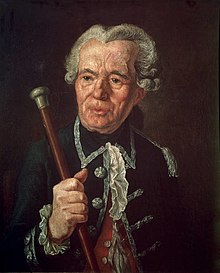Bernard-René Jordan de Launay

Bernard-René Jourdan, Marquis de Launay , also written de Launey after his own signature , first name also Jordan (born April 8, 1740 in Paris (Bastille); † July 14, 1789 in Paris (murdered)) was a French nobleman from Paris and the last commandant of the Bastille in Paris (1776–1789).
His parents were René Jourdan de Launay , Chevalier des Ordre royal et militaire de Saint-Louis , commandant of the Bastille (1718 to 1749), and Charlotte Renée Aubry d'Armanville . Jourdan followed Antoine-Joseph Chapelle de Jumilhac in 1776 in the post of commandant. At the beginning of the French Revolution he was the commandant (title of the head of the Bastille originally French capitaine , then commandant ('commander' of the occupation), most recently governor ('head'; under Henry IV. Separate offices)) of the Bastille prison and commanded the small garrison stationed there .
On the day the Bastille was stormed , July 14, 1789, however, she was guarding only seven prisoners. De Launay was overwhelmed by the situation of the uprising. He initially had the rebels shot, but later wanted to hand over the fortress. For unknown reasons, however, there was another shooting, in which over 80 people (a total of 98 dead) were killed. Eventually De Launay hoisted a white flag and surrendered to the crowd with his people. After his capture, he was supposed to be brought to the town hall by Pierre-Augustin Hulin (soldier, born September 6, 1758 in Paris, † January 9, 1841 in Paris), one of the leaders of the rebels. On the way there he was attacked by an angry crowd and finally killed in the Place de Grève with multiple knife and bayonet stabs and one shot after he kicked an unemployed cook in the abdomen in order to defend himself. A butcher and later revolutionary ( Mathieu Jouve Jourdan , called Coupe-Têtes ('head cutter')) cut off his head, which was then carried on a pole to the town hall. De Launay is considered to be the first prominent victim of the French Revolution.
Web links
| personal data | |
|---|---|
| SURNAME | Launay, Bernard-René Jordan de |
| ALTERNATIVE NAMES | Launey, Bernard-René Jourdan Marquis de |
| BRIEF DESCRIPTION | French prison commandant |
| DATE OF BIRTH | April 8, 1740 |
| PLACE OF BIRTH | Paris |
| DATE OF DEATH | July 14, 1789 |
| Place of death | Paris |
